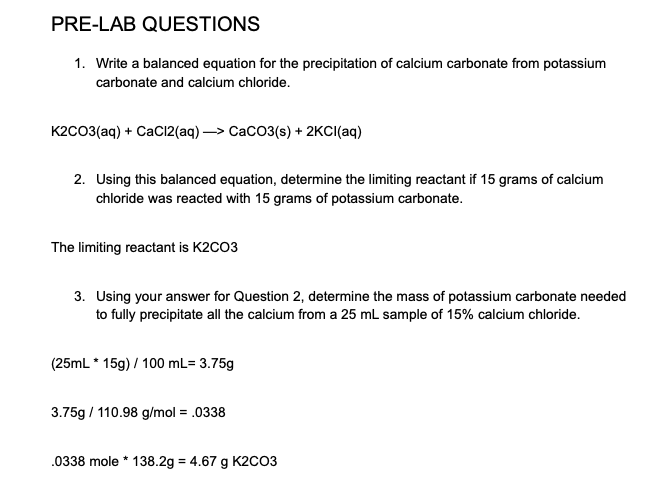

Since concentration of hydroxide ions is low, calcium hydroxide remains soluble. The composition of the solution for the bioscience process is basically formed by the following elements: yeast extract, ammonium chloride (NH 4 Cl), peptone, meat extract, sodium bicarbonate, urea (NH 2) 2 CO and calcium chloride (CaCl 2), under different types of concentration combinations (Stocks-Fischer et al. Reaction of CaCl 2 and Na 2 CO 3 and balanced equation Reactants of reactions Products of. In this tutorial, we will discuss followings. We described a precipitation reaction in which a colorless solution of silver nitrate was mixed with a yellow-orange solution of potassium dichromate to give a reddish precipitate of silver dichromate. Calcium carbonate is a white precipitate and insoluble in water. A precipitation reaction is a reaction that yields an insoluble producta precipitatewhen two solutions are mixed. It partially ionizes in aqueous solution to form low concentration of hydroxide ions. Calcium chloride (CaCl 2) reacts with sodium carbonate (Na 2 CO 3) and form calcium carbonate (CaCO 3) and sodium chloride (NaCl). If the concentration of these ions are high, white precipitate will form.Īqueous ammonia is a weak alkali. This means that it will be soluble if the concentration of calcium and hydroxide ions are low. In the next step, the remaining metal impurities were removed as solid. why no precipitate is formed when aqueous ammonia is added to calcium salt Reason:Ĭalcium hydroxide is partially soluble/ sparingly soluble. The precipitate is in the form of Fe(OH)3, which converts to Fe2O3 when annealed in air. If no precipitate is formed, we can confirm that the ion present is calcium ion. Could this affect bacterial transformation when using the Calcium chloride method I am preparing competent cells using calcium. Students are required to describe the use of aqueous sodium hydroxide and aqueous ammonia to identify the following aqueous cations: aluminium (Al 3+), ammonium (NH 4 +), calcium (Ca 2+), copper(II) (Cu 2+), iron(II) (Fe 2+), iron(III) (Fe 3+), lead(II) (Pb 2+) and zinc (Zn 2+) (formulae of complex ions are not required).įor easy memory, you may wish to first divide the cations into 2 groups – precipitate formed and no precipitate formed.Īddition of aqueous ammonia to different cations No Precipitate formed Calcium chloride dihydrate precipitates after autoclaving. As calcium carbonate is precipitated in a solution containing ammonium chloride, calcium chloride, and ammonia, the product needs to be washed and hence filtered. Qualitative Analysis is the process of identifying unknown substances in a solution. In this Chemistry learning video, we focus on why no precipitate is formed when aqueous ammonia is added to calcium salts.


 0 kommentar(er)
0 kommentar(er)
